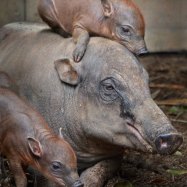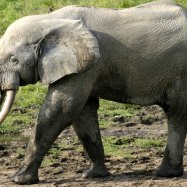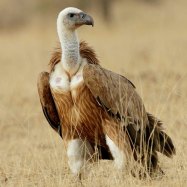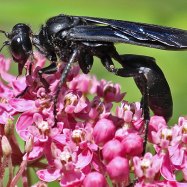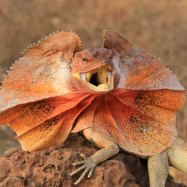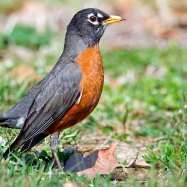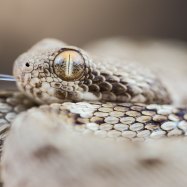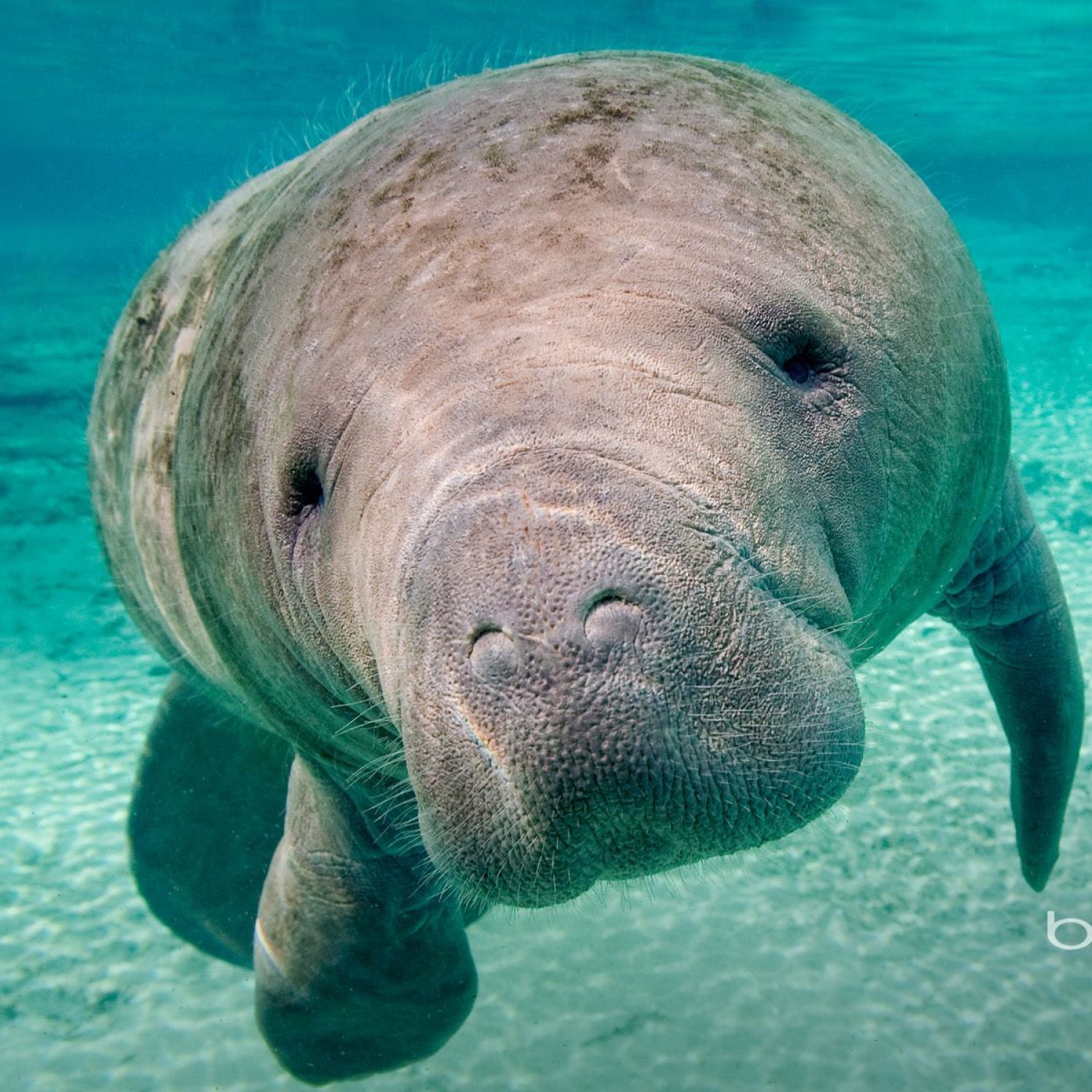
Manatee
9 to 12 feet
Discover the gentle giants of the sea - the manatees! These marine mammals, also known as sea cows, can grow up to 12 feet in length and weigh over 1,000 pounds. Found in warm coastal waters, rivers, and estuaries, these animals have a unique body shape that is large, robust, and streamlined. Belonging to the Trichechidae family, manatees play an essential role in maintaining the balance of their aquatic habitats. Learn more about these fascinating creatures and their conservation efforts. #manatees #seacows #marineanimals
Animal Details Summary:
Common Name: Manatee
Kingdom: Animalia
Habitat: Aquatic
The Mighty Manatee: A Gentle Giant of the Aquatic World
When we think of majestic creatures of the sea, our minds often jump to the sleek and powerful dolphins or the fearsome sharks. However, there is another aquatic animal that deserves our attention and admiration - the manatee. Also known as the sea cow, the manatee is a remarkable mammal that has captured the hearts of many with its gentle nature and unique characteristics.A Brief Introduction to the Manatee
The manatee, scientifically known as Trichechus, is a mammal belonging to the Sirenia order, which also includes the dugong and the extinct Steller's sea cow Manatee. Although they are often referred to as "sea cows," manatees are more closely related to elephants and hyraxes. They are slow-moving herbivores that can be found in warm waters and are well-known for their docile nature.There are three species of manatees - the Amazonian manatee, West Indian manatee, and West African manatee. The West Indian manatee, also known as Trichechus manatus, is further divided into two subspecies - the American manatee and the Antillean manatee. These species can be found in various regions, including North and Central America, South America, and Africa.
The Habitat and Distribution of Manatees
Manatees are primarily aquatic animals that inhabit warm coastal waters, rivers, and estuaries. They prefer shallow, slow-moving water bodies, making them commonly found in wetland areas. Because of their warm-water habitat, they are often found in tropical and subtropical regions. In the United States, they can be found in Florida, Georgia, and Puerto Rico Mockingbird.The geographical distribution of manatees is limited to the North and Central American region and parts of Africa. In the United States, the largest population of manatees is found in Florida, with over 6,500 individuals. They are also found in the Caribbean, Mexico, and Central and South America. In Africa, they are mainly found in the coastal regions of West Africa.
The Unique Adaptations of Manatees
One of the most remarkable features of manatees is their body shape. They have a large, robust, and streamlined body that helps them move effortlessly through the water. This body shape is essential for their slow-moving nature as it minimizes resistance and allows them to conserve energy while swimming.Manatees also have a unique adaptation called flippers, which are modified front limbs that help them navigate through water. These flippers are broad, paddle-like structures that can rotate 180 degrees, allowing the manatees to swim backward and move in tight spaces. They also use these flippers to bring food to their mouths and groom themselves.
Their skin is another noteworthy adaptation as it is thick and tough to help them withstand the harsh conditions of their habitat. It is also covered in a layer of algae, which makes them look greenish in color. The algae not only helps with camouflage but also provides nutrients to their bodies.
Feeding Habits of Manatees
Manatees are herbivorous animals, which means they feed primarily on plants. They are known to consume up to 10% of their body weight in vegetation daily. This diet mainly consists of sea grasses, mangrove leaves, and various aquatic plants. As they do not have front teeth, they use their large and flexible lips to grind and chew their food.Their feeding method also plays a crucial role in maintaining the balance of the ecosystem. They act as ecosystem engineers, preventing the overgrowth of vegetation in water bodies. By grazing on the plants, they help maintain the health and diversity of aquatic ecosystems.
Threats and Conservation Efforts
Despite their gentle nature, manatees face numerous threats in their natural habitat. One of the greatest threats to their survival is human activity. As manatees are slow-moving, they are often hit by boats and suffer from injuries or fatalities. They also get trapped in fishing nets or ingesting harmful debris, leading to health issues.Climate change also poses a severe threat to the manatees' survival. The rising sea levels and changes in water temperature can impact their food sources, habitat, and migration patterns.
To protect these gentle giants, various conservation efforts have been put in place. In the United States, manatees are protected under the Endangered Species Act, which prohibits any intentional killing, harassment, or harm to these marine animals. Other measures include speed restrictions in areas where manatees are known to inhabit and initiatives to remove debris from the waterways.
Fun Facts about Manatees
1. Manatees can hold their breath for up to 20 minutes.2. They have the longest digestive system among all mammals, stretching up to 150 feet.
3. Manatees have a low metabolism and can survive on just 3% of their body weight in food each day.
4. Despite their large size, manatees are agile swimmers and can reach speeds of up to 20 miles per hour.
5. They are social animals and can be found in herds, usually consisting of 3 to 10 individuals.
In Conclusion
Manatees may not be the most well-known or exotic creatures on the planet, but they are undoubtedly a wonder of the aquatic world. These gentle giants play a significant role in maintaining the balance of their ecosystems and have captured the hearts of many with their unique characteristics. It is our responsibility to protect and preserve these magnificent animals for future generations to come.

Manatee
Animal Details Manatee - Scientific Name: Trichechus
- Category: Animals M
- Scientific Name: Trichechus
- Common Name: Manatee
- Kingdom: Animalia
- Phylum: Chordata
- Class: Mammalia
- Order: Sirenia
- Family: Trichechidae
- Habitat: Aquatic
- Feeding Method: Herbivorous
- Geographical Distribution: North and Central America, Africa
- Country of Origin: United States
- Location: Warm coastal waters, rivers, and estuaries
- Animal Coloration: Grayish-brown
- Body Shape: Large, robust, and streamlined
- Length: 9 to 12 feet
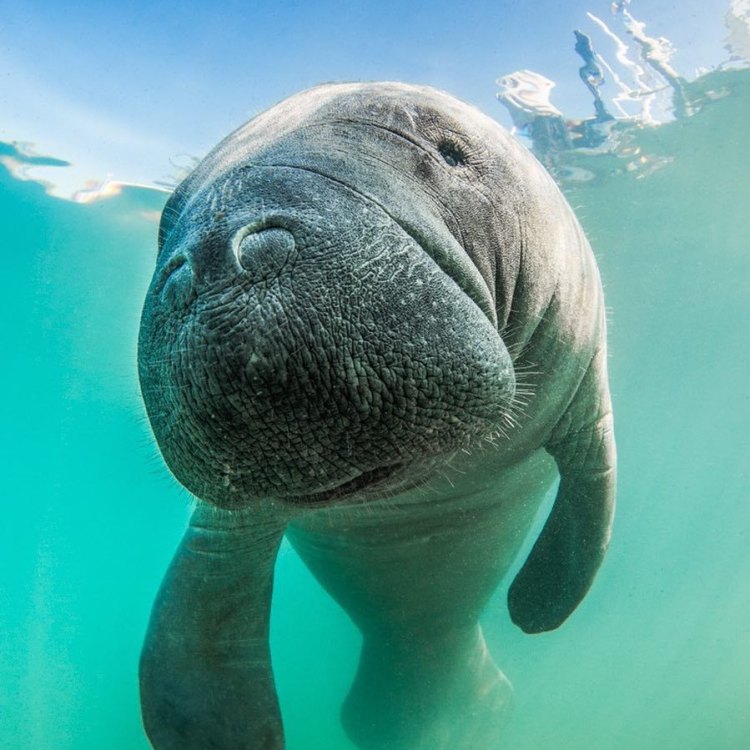
Manatee
- Adult Size: Up to 13 feet long and weigh over 3,000 pounds
- Average Lifespan: 40 to 60 years
- Reproduction: Sexual
- Reproductive Behavior: Polygynous
- Sound or Call: Manatees make underwater vocalizations and squeaks
- Migration Pattern: Seasonal migrations
- Social Groups: Generally solitary or found in small groups
- Behavior: Slow-moving and gentle
- Threats: Habitat loss, boat collisions, pollution, and climate change
- Conservation Status: Vulnerable
- Impact on Ecosystem: Critical for maintaining the health of aquatic ecosystems
- Human Use: Tourism, hunting (historically)
- Distinctive Features: Large body, paddle-like flippers, and a rounded tail
- Interesting Facts: Manatees are also known as sea cows and are herbivorous marine mammals
- Predator: Humans (historically)
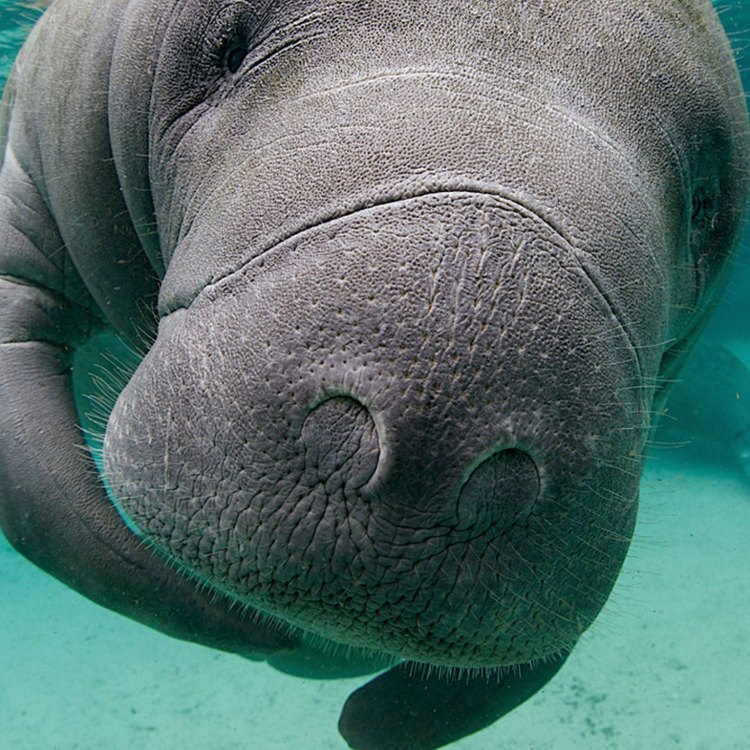
Trichechus
The Gentle Giants of the Sea: Exploring the World of Manatees
The ocean is a vast and mysterious place, filled with a diverse array of creatures. From tiny fish to massive whales, the sea is home to a myriad of fascinating animals. One such animal that captures the hearts of many is the majestic and gentle manatee.Known as the "gentle giants of the sea," manatees are an iconic species native to the warm, shallow waters of the Caribbean, Gulf of Mexico, and some parts of the Amazon River PeaceOfAnimals.Com. These magnificent creatures, also known as sea cows, have captured the imagination of people around the world with their unique features and gentle demeanor. Let's dive deeper into the world of manatees and uncover what makes them such special creatures.
Adult Size and Lifespan
The manatee is a large aquatic mammal that can grow up to 13 feet in length and weigh over 3,000 pounds. Despite their massive size, manatees have small heads and a round, plump body. Their bodies are streamlined, making it easy for them to glide through the water.
One of the most fascinating things about manatees is their long lifespan. They can live up to 40 to 60 years in the wild, making them one of the longest-living marine mammals. In captivity, manatees have been known to live up to 69 years, which is a testament to the excellent care they receive at accredited facilities.
Reproduction and Reproductive Behavior
Like many other mammals, manatees reproduce sexually Muskrat. They do not have a specific mating season, but instead, their reproduction is determined by water temperature and food availability. Female manatees reach sexual maturity at around five years old, while male manatees reach maturity at around eight years old.
Manatees have a unique reproductive behavior known as polygyny, which means that one male will have multiple female mates. Male manatees will mate with multiple females in their territory, and sometimes, they will form small mating herds with several females. This behavior ensures the survival of the species, as more females can reproduce and produce offspring.
Sound or Call of Manatees
Manatees may not be the most vocal creatures, but they do make sounds and calls underwater. These vocalizations include clicks, squeaks, and chirps, and they are produced by the manatee's larynx. Manatees use vocalizations to communicate with each other and to navigate their surroundings.
Interestingly, manatees also have specialized vocal cords that allow them to vocalize underwater. This adaptation allows them to communicate easily while swimming in the water, where most other animals would have trouble producing sounds.
Migration Pattern
Manatees are known for their seasonal migrations, where they travel to find warm-water refuges in the winter months. As water temperatures drop, manatees seek out the warm-water springs and power plant outflows along the Gulf coast of Florida. These refuges help them survive the colder months, as manatees cannot tolerate water temperatures below 68 degrees Fahrenheit for extended periods.
During their migration, manatees will travel considerable distances, sometimes up to 50 miles, to reach these warm-water refuges. These migrations are essential for their survival and also contribute to the dispersion of their species, ensuring a healthy gene pool.
Social Groups and Behavior
Manatees are generally solitary animals or can be found in small groups of two or three individuals. However, during mating season, they will form small herds as males compete for female mates. Manatees are also known for their peaceful and gentle behavior, earning them the moniker "gentle giants of the sea."
These slow-moving creatures spend most of their day grazing on aquatic vegetation, which makes up the majority of their diet. Manatees can consume up to 10% of their body weight in vegetation daily, as they need a significant amount of food to sustain their large body size.
Threats and Conservation Status
Despite their gentle nature, manatees face numerous threats that put their survival at risk. The most significant threat to manatees is habitat loss. As coastal areas continue to develop and expand, manatees are losing their natural habitats, which forces them to seek refuge in other areas.
Another significant threat to manatees is boat collisions. Due to their slow-moving behavior, manatees are prone to getting hit by boats, resulting in serious injuries or death. Pollution and climate change also have a detrimental impact on manatees, as it affects their food sources and can make the water too cold for them to survive.
Due to these threats, manatees are listed as a vulnerable species by the International Union for Conservation of Nature (IUCN). This means that they are facing a high risk of extinction in the wild if steps are not taken to protect and conserve their species.
Impact on Ecosystem and Human Use
Manatees play a critical role in maintaining the health of aquatic ecosystems. As herbivorous animals, they help control the growth of aquatic vegetation, keeping the ecosystem in balance. They also play a role in the dispersal of plant seeds, contributing to the growth and diversity of aquatic plants.
Their peaceful nature also makes them a popular attraction for tourists, who come to swim and interact with these gentle creatures. However, manatees have also been hunted historically for their meat, making them an important source of food for humans in the past.
Distinctive Features and Interesting Facts
Manatees have several distinctive features that make them stand out from other marine mammals. Their large body size, paddle-like flippers, and a rounded tail make them easily recognizable. They also have thick, bristly hair that covers their bodies, helping them stay warm in cold water.
Despite being slow-moving, manatees are impressive swimmers. They can swim up to 15 miles per hour, and when they are in a hurry, they can even reach speeds of up to 20 miles per hour. It's also fascinating to note that manatees are more closely related to elephants than any other marine mammal, with their closest living relatives being the dugong.
Predators and Human Interaction
Historically, the main predator of manatees was humans. Manatees were hunted for their meat, blubber, and skin, which was used to make boats and ropes. However, today, they are protected by law in most countries, and hunting is no longer a significant threat to their survival.
However, human activities such as habitat destruction, boat collisions, pollution, and climate change continue to be major threats to their populations. It's essential for humans to continue to take steps to protect and conserve these gentle creatures to ensure their survival for future generations to appreciate.
In Conclusion
Manatees are a unique and fascinating species, and they play a crucial role in maintaining the health and balance of aquatic ecosystems. Despite being gentle and peaceful creatures, they face numerous threats that put their survival at risk. It is our responsibility to protect and conserve these magnificent creatures to ensure their survival for future generations. By spreading awareness and taking steps to reduce our impact on their habitats, we can help secure a brighter future for the gentle giants of the sea – the manatees.
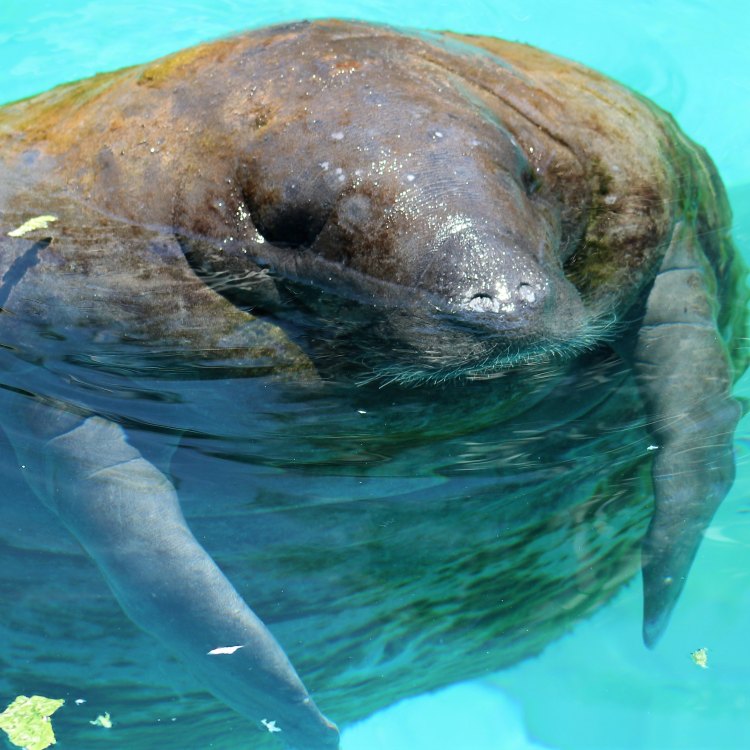
The Mighty Manatee: A Gentle Giant of the Aquatic World
Disclaimer: The content provided is for informational purposes only. We cannot guarantee the accuracy of the information on this page 100%. All information provided here may change without prior notice.


